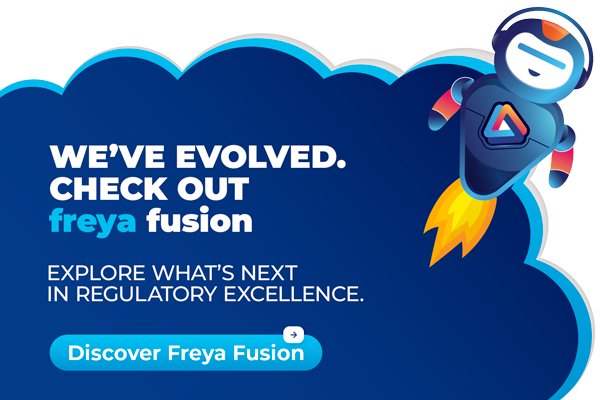
Introduction
In today’s fast-paced pharmaceutical landscape, regulatory complexity has never been greater. From evolving global submission guidelines to proliferating post-market safety requirements, regulatory affairs teams juggle immense volumes of documents, data points, and evolving standards. Manual processes struggle to keep pace, risking delays, compliance gaps, and lost competitive edge.
Enter Generative AI-an emerging game-changer in regulatory technology that can automate tedious tasks, unearth actionable insights, and forecast regulatory outcomes. As a Regulatory Technology Expert, I’ve seen firsthand how a next-gen unified RIMS (Regulatory Information Management System) like freya fusion formerly Freyr Digital’s flagship platform is leveraging AI to tackle real-world challenges around document generation, compliance monitoring, post-market surveillance, and more. In this post, we’ll explore five high-impact Generative AI use cases that are transforming pharma regulatory affairs-and show where freya fusion modules slot in as powerful enablers.
Automated Regulatory Document Generation
The Challenge
Pharma submissions require assembling large volumes of regulated documents-drug master files, Module 3 quality dossiers, labeling supplements, and more-each with strict format, metadata, and cross-reference requirements. Manual assembly can be error-prone, time-consuming, and difficult to track.
How Generative AI Helps
- Dynamic Content Assembly: AI models intelligently match and stitch content components (e.g., stability data, manufacturing descriptions) into templates.
- Metadata Validation: Automated checks ensure required metadata fields (country codes, document types, version histories) are complete and compliant.
- Natural-Language Refinement: Drafted sections are polished for consistency with regulatory style guides.
freya fusion Modules in Action
| Use Case | freya fusion Module | Key Capabilities |
| Component-based content reuse | freya.content | Structured authoring; topic-based content library |
| Document management & validation | freya.docs | Dynamic metadata; real-time compliance checks |
| Workflow automation & eCTD publishing | freya.automate | Automated sequence assembly; publishing orchestration |
Insider Tip: By integrating freya.content’s component reuse with freya.docs’ validation engine, teams can cut first-pass document assembly efforts by up to 60%.
Clinical Study Report (CSR) Automation
The Challenge
Clinical Study Reports (CSRs) are among the most substantive documents in a submission, often exceeding hundreds of pages. Creating and formatting CSRs-complete with tables, figures, and appendices-demands meticulous coordination between writers, statisticians, and reviewers.
How Generative AI Helps
- Auto-Drafting Narrative Sections: AI can draft background, methodology, and results of narratives by synthesizing study data inputs.
- Template-Driven Formatting: Ensures tables, listings, and figures adhere to ICH E3 guidelines without manual rework.
- Collaborative Reviews: Natural-language suggestions guide reviewers on required edits or missing data points.
freya fusion Modules in Action
- content: Build CSRs component-by-component-narratives, tables, figures-using a centralized content library.
- automate: Sequence CSRs through predefined review and approval workflows, with AI-driven guidance at each step.
- docs: Capture audit-ready version histories; enable simultaneous editing and comment resolution.
Impact Story: One submission manager cut CSR cycle time by 30% after deploying AI-driven drafting and review workflows.
Regulatory Intelligence & Compliance Monitoring
The Challenge
Global regulators issue hundreds of updates monthly-guidance documents, labeling revisions, inspection findings. Staying on top of changes and assessing their relevance to existing products is like finding needles in a haystack.
How Generative AI Helps
- Continuous Scanning: AI bots monitor regulatory websites, journals, and newsfeeds for new directives.
- Smart Summaries: Natural-language summaries highlight action items, affected regions, and deadline impacts.
- Query Prediction: Models forecast likely regulatory questions (RTQs) based on past authority interactions.
freya fusion Modules in Action
| Function | Module | Highlights |
| Regulatory change monitoring | freya.intelligence | Always-on data feeds; real-time alerts |
| RTQ repository & drafting support | freya.RTQ | Query prediction; response templates |
| Customizable alerts & newsletters | freya.alerts | Role-based digests; escalation workflows |
Expert Insight: Embedding freya.intelligence and freya.RTQ into your regulatory operations reduces manual monitoring effort by over 70%, while boosting compliance confidence.
Post-Market Surveillance & Safety Monitoring
The Challenge
After approval, products enter the real-world environment where new safety signals can emerge. Monitoring adverse event databases, literature reports, and regulatory bulletins is critical to managing product risk and meeting pharmacovigilance obligations.
How Generative AI Helps
- Signal Detection: AI algorithms scan diverse data sources to flag emerging safety trends.
- Risk Summarization: Condensed summaries of adverse event clusters enable rapid safety assessments.
- Regulatory Reporting: Auto-populate PSURs and PADERs with AI-curated data insights.
freya fusion Modules in Action
- intelligence: Aggregates and analyzes multi-source safety data; delivers decision-support dashboards.
- alerts: Configurable notifications for safety-related label changes, Black Box alerts, and more.
Real-World Example: A mid-sized biotech used AI-powered signal detection to identify a rare adverse event pattern two weeks earlier than manual review.
Predictive Analytics for Regulatory Outcomes
The Challenge
Estimating approval timelines, anticipating regulatory queries, and choosing optimal submission strategies often rely on gut feel or historical averages-hardly precise in today’s dynamic environment.
How Generative AI Helps
- Approval Timeline Forecasting: ML models predict review durations based on dossier completeness, regulator workload, and region.
- Query Likelihood Scoring: AI assesses submission risks to forecast expected number and type of RTQs.
- Scenario Analysis: Simulate “what-if” submission strategies to optimize dossier structure and country sequences.
freya fusion Modules in Action
| Capability | Module | Benefit |
| HA query forecasting | freya.RTQ | Risk-based drafting; query risk heatmaps |
| Regulatory outcome simulation | freya.intelligence | Scenario-based insights; approval probability tracking |
Business Value: Predictive insights help plan resource allocation, reducing unplanned delays by up to 50%.
Key Regulatory Challenges & How Generative AI Helps
- Document Overload
AI Solution: Automated assembly, dynamic validation, and intelligent routing streamline processes. - Global Compliance Variability
AI Solution: Continuous intelligence monitoring and query forecasting ensure local requirements are met. - Time-to-Market Pressure
AI Solution: Predictive analytics optimize submission strategies and resource planning. - Post-Approval Risk Management
AI Solution: Signal detection and automated reporting accelerate safety actions.
By tackling these pain points, AI-powered platforms like freya fusion position regulatory teams to operate more proactively and with greater confidence.
Why Choose Domain-Specific Generative AI Solutions for Regulatory Affairs
Generic AI tools lack the depth needed for highly regulated environments. Domain-specific solutions like freya fusion offer:
- Built-In Regulatory Taxonomies: Pre-trained on pharma vocabularies and submission standards.
- End-to-End Integration: From document drafting to post-market surveillance in one unified RIMS.
- Audit-Ready Compliance: Automatically capture version histories, change logs, and approval trails.
- Seamless Scalability: Cloud-native architecture to support global teams and high-volume pipelines.
This specialization ensures outputs align with regulatory expectations-mitigating risk and accelerating approvals.
Business Impacts: Speed, Cost-Savings & Competitive Advantage
Generative AI isn’t just a technical novelty-it delivers measurable ROI:
| Impact Metric | Pre-AI Baseline | Post-AI Improvement |
| Document assembly time | 10 days | 4 days (–60%) |
| CSR review cycle | 8 weeks | 5.5 weeks (–31%) |
| Regulatory monitoring effort | 100 hours/month | 30 hours/month (–70%) |
| Approval delay rate | 25% | 12% (–52%) |
These gains translate into:
- Faster time-to-market, unlocking earlier revenue streams
- Lower operational costs through reduced manual labor
- Stronger compliance posture, minimizing inspection risks
- Enhanced decision-making, with data-driven insights at every stage
- What is Generative AI in pharma regulatory affairs and why does it matter? Generative AI refers to advanced machine-learning models that can draft, refine, and assemble regulatory documents, analyze data trends, and predict outcomes. In pharma regulatory affairs, it automates repetitive tasks-like dossier creation, labeling updates, and safety reporting—thereby reducing manual effort, minimizing errors, and accelerating time-to-market.
- How does Generative AI streamline regulatory document generation? By leveraging component-based content libraries and dynamic metadata validation, Generative AI automatically assembles sections (e.g., Module 3 quality data, clinical tables) into compliant templates. It ensures consistent formatting, flags missing fields, and polishes language to regulatory style guides—cutting assembly time by up to 60%.
- Can Generative AI predict regulatory submission outcomes? Yes. Predictive analytics models trained on historical submission data forecast approval timelines, likely queries (RTQs), and optimal country sequencing. This insight helps submission managers allocate resources effectively, reduce unplanned delays by over 50%, and make informed strategic decisions.
- How does Generative AI enhance post-market surveillance and safety monitoring? Generative AI continuously scans adverse-event databases, literature, and regulatory bulletins to detect emerging safety signals. It uses natural-language summarization to highlight risk trends, auto-populate PSURs/PADERs, and issue real-time alerts-enabling faster, data-driven safety assessments.
- What are the benefits of using a unified AI-powered RIMS like freya fusion? A domain-specific platform such as freya fusion integrates document automation (freya.docs, freya.content), AI-driven intelligence (freya.intelligence, freya.RTQ), and automated workflows (freya.automate) in one system. This end-to-end solution ensures audit-ready compliance, seamless collaboration, and measurable ROI-accelerating approvals and cutting operational costs.
Final Thoughts
Generative AI is redefining what’s possible in pharma regulatory affairs. By automating mundane tasks, providing real-time intelligence, and forecasting regulatory outcomes, it empowers teams to focus on strategic decision-making and patient-centric innovation.
As you navigate growing regulatory demands, consider how a unified, AI-powered RIMS like freya fusion can serve as your next-gen regulatory technology platform. Offering end-to-end regulatory management-from freya.docs and freya.content to freya.intelligence, freya.RTQ, and freya.automate-it’s crafted to address real-world challenges with precision and scalability.
Ready to transform your regulatory operations? Learn more about freya fusion’s capabilities and book a personalized demo today. Your pathway to faster approvals, stronger compliance, and measurable ROI starts here.
About the Author
Wasi Akhtar is a Regulatory Technology and Digital Transformation Expert who combines program management prowess with deep pharmaceutical regulatory domain knowledge. He drives AI-enabled RIMS implementation for medicinal products and ensures seamless technology transfers.
